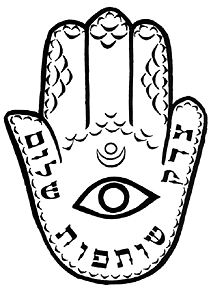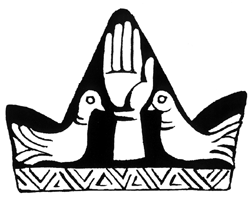 Hamsa
for Peace
Hamsa
for Peace
The blessing hand of Goddess appeared in sacred art of the ancient Canaanites, Phoenicians, and Tunisians. Even after Goddess veneration was driven underground, her sign continued to be revered by Jews, Christians and Muslims, who still wear it in protective amulets. It has appeared in Christian art in Egypt, Hannukah candelabras in Iraq, and Muslim processional staffs in India. The name Hamsa means "five" in Arabic. Muslims also call this sign the“Hand of Fatima,” in honor of Muhammad’s daughter. The Hamsa’s ancient origins represent commonality across modern divisions, a blessing with unifying potential. This Hamsa is inscribed Tzedek, Shutafut, Shalom: Hebrew for "Justice, Partnership, Peace."
(Card color: Black on golden-tan parchment)
 Hand
of Tanit
Hand
of Tanit
Carthage, Tunisia The blessing hand of the goddess Tanit came to north Africa with the Phoenicians. Their Canaanite cousins also revered this symbol and the dove which was sacred to Atargatis in Syria, Astarte in Palestine, and Aphrodite in Cyprus. In ancient Tunisia, limestone stelas combine the blessing hand with palm trees, horned pillars, and an abstract triangular image of Tanit with her arms raised in benediction. Late Carthaginian and Egyptian art continue to portray women with one hand raised in the gesture of benediction.
(Card color: black on peach)
Shamanic | Deasophy | Kindreds | Order
Copyright 2000 Max Dashu